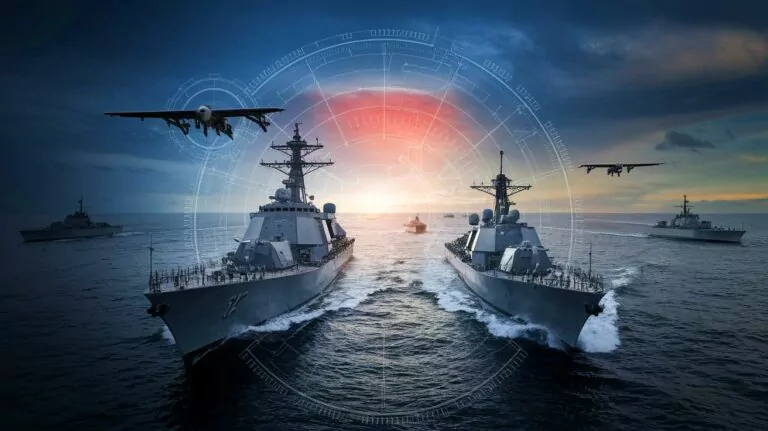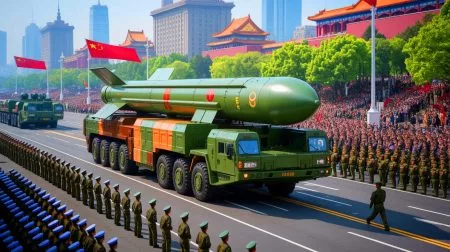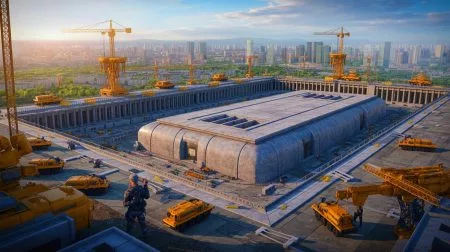| IN A NUTSHELL |
|
The dynamics of modern warfare are rapidly evolving, and recent reports highlight a significant shift in maritime conflict strategies. A simulation conducted by Chinese forces demonstrated the resilience and strategic capabilities of a single Type 055 destroyer and its escort against a formidable missile attack by a group of Arleigh Burke-class destroyers. This event, set in the western Pacific near Taiwan, underscores the increasing importance of unmanned technology and innovative defense measures in contemporary military engagements. The outcome of this simulation not only highlights the prowess of Chinese naval technology but also poses critical questions about the future of naval warfare.
The Role of Unmanned Technology in Modern Warfare
The Chinese simulation emphasized the strategic integration of unmanned technology in naval operations. The Type 055 destroyer was not solitary in its defense; it was supported by unmanned drone mothership vessels. These motherships were equipped with a fleet of 32 drones and 14 unmanned boats, illustrating the shift towards autonomous warfare systems. Such technology provides a tactical advantage, enabling rapid response and flexibility in dynamic combat scenarios.
The use of drones and unmanned boats in this simulation highlights the potential for reduced human risk and increased operational efficiency. These unmanned systems can perform reconnaissance, surveillance, and direct combat roles, transforming traditional naval strategies. By employing such technology, the Chinese military aims to redefine maritime conflict, leveraging cost-effective and technologically advanced platforms to counter traditional naval forces.
Economic Implications of Missile Warfare
The economic aspect of missile warfare is a crucial consideration in modern military conflicts. The simulation revealed significant cost disparities between Chinese and U.S. missile systems. American missiles, such as the Tomahawk and LRASM, range between $1 million and $3 million per unit, placing substantial financial strain on military budgets during prolonged engagements.
In contrast, Chinese missile systems are reported to cost significantly less, ranging from $400,000 to $1,000,000 per missile. This economic advantage allows China to sustain longer engagements with less financial burden, making their strategy both effective and economically viable. The cost-effectiveness of Chinese missile systems is a critical factor in their military strategy, potentially altering the balance of power in future conflicts.
This 1,100-foot nuclear titan – China’s colossal warship sets sail to challenge US naval dominance
Technological Advancements and Naval Superiority
The simulation conducted by the China Ship Development and Design Centre (CSDDC) and Huazhong University of Science and Technology showcased the technological advancements of Chinese naval forces. The Type 055 destroyer, supported by its unmanned escorts, successfully intercepted all incoming missiles, demonstrating advanced detection and countermeasure capabilities.
Such technological superiority is vital in maintaining strategic dominance in maritime regions. The ability to detect and intercept threats with high precision not only protects valuable assets but also deters potential adversaries. As China continues to invest in cutting-edge technology, their naval forces are poised to challenge traditional maritime powers, reshaping the geopolitical landscape in regions like the western Pacific.
240-ton maritime marvel unveiled – This autonomous ship navigates without a single crew member
Challenges and Limitations of the Simulation
Despite the impressive results of the simulation, there are limitations and challenges that must be addressed. One major concern is the selection of the Arleigh Burke-class destroyers as adversaries. While powerful, these ships are aging, having been first launched in the 1980s. This choice may not accurately reflect the capabilities of more modern vessels, potentially skewing the results of the simulation.
Furthermore, while the simulation demonstrates China’s military capabilities, real-world conflicts present unpredictable variables that simulations cannot fully replicate. Factors such as environmental conditions, enemy tactics, and technological malfunctions can significantly impact outcomes in actual combat scenarios. These considerations underline the need for continuous innovation and adaptation in military strategies.
As global powers advance their military technologies, how will traditional naval forces adapt to the increasing prevalence of unmanned systems and economically viable missile strategies in modern warfare?
Did you like it? 4.6/5 (20)








Is this simulation a sign of things to come in real-world conflicts? 🤔
Google are you now a mouth piece for china hawks
Yes
I say the heck with playing games let’s get it on if it’s gonna happen let’s get it going. Get it over with would’ve been playing games back in the 60s. This country wouldn’t be here right now. I don’t play games.
Why were the Arleigh Burke-class destroyers chosen? Seems like an odd choice. 🤨
Because we have made ourselves their enemy.
Interesting read, but how reliable are these Chinese simulations?
What is a publication supposedly about sustainability and environmentalism doing reporting on “so called” Chinese military advancements?
Seems like a PR move more than anything. Real-world scenarios are different.
Thanks for the article! It’s amazing how technology is changing warfare. 😮
China’s naval strategy is becoming more sophisticated by the day. 🚢
The economic implications of this are huge! Thanks for highlighting them. 💰
Has the U.S. responded to this simulation in any way?
Are drones really the future of warfare? They seem vulnerable to hacking.
Thanks for the article! So much information to digest. 😅
How do you think other nations will respond to this technological shift?
I wonder how this impacts Taiwan’s security situation. 🤔
Looks like the U.S. has some catching up to do…
Does anyone else find this simulation a bit exaggerated?
Great article! The future of naval warfare is certainly intriguing. 🚀
Can anyone verify the cost of these missiles? Sounds too good to be true.
No more than anyone can verify the author or 90% of the commenters here.
I hope the U.S. is paying attention to these developments. 🧐
China’s military capabilities are growing rapidly. Time to rethink strategies!
Should we be concerned about the balance of power in the Pacific?
This feels like a sci-fi movie plot! 🤖
The choice of opponents in the simulation seems questionable. 🤨
Can someone explain what a “kill web” is? I’m lost! 😂
Thanks for the insights! What a fascinating read. 😊
Can these simulations really predict realistic outcomes?
The integration of drones is a game-changer for China. 🚁
Is the U.S. falling behind in terms of naval technology?
Why isn’t there more international oversight on such simulations?
Wow, this article is a real eye-opener. Thanks for sharing! 👏
How will this affect future military budgets and spending?
Anyone else think the term “kill web” sounds a bit dramatic? 😅
Are there any countermeasures for these unmanned systems?
Wow. So believable. Laureen fagan almost sounds like a real person.
WOW. THIS IS SO BELIEVABLE (LOL)
Simulations are well and good but forget that the enemy (in this case the US) has a say.
Is it possible to trust simulations? They can’t account for every variable.
The cost difference in missiles is truly eye-opening. 💸
Wow. So believable. Laureen fagan almost sounds like a real person.
It’s worrying how quickly warfare technology is advancing. 😟
Why isn’t the U.S. developing similar unmanned technologies?
The Chinese do not have everything they need,they are trying to develop it because of the sanctions and tariffs that is on the country,this article is false the United States has Drones as well and Hypersonic Missles now,plus alot of Taiwan’s Chip are made here in the US,plus Japan just received lots of Brand new F-15EX fighters to boost there attack power,not too mention the South Koreans are getting gears up for China and North Korea.The Philippines are beefing things up as well and Vietnam,Indonesia Australia, plus India so this so called test forgot about all of that as well,not to mention the US Attack submarines and other assets
If China Attacks Taiwan it will Destroy the Chinese economy.
We have weapons no one even knows about. I’m not worried.
China is a communist dictstorship. Of course things like missles cost less. Older Arleigh Burke destroyers get upgrades with new weapons and radar systems. Simulations can be designed to make most anything you want seem undefeatable. I could go on, but why bother. Reality will always trump talk. The Chinese release these stories to the world to scare opponents. Well, Kipling’s comment (paraphrased), no one knows how they will behave until they’ve seen the elephant, could read no one knows how a weapons system will work until it’s used for real combat. Talk is cheap. This outlet just made it cheaper. Simulation like work according to their design. We have no knowledge of how much they “stacked” this test. Take it to be a boast that makes potential adversaries “blink”. The Chinese lie, cheat, steal, and hack. They also brag and threaten. Typical “Bully” behavior. Treat this as such.
Well, like most people my age, we don’t play games if they wanna get it on, let’s get it on talking about. It ain’t gonna do any good and play in tiddly winks ain’t gonna help